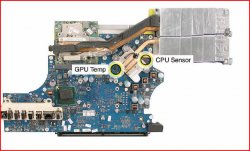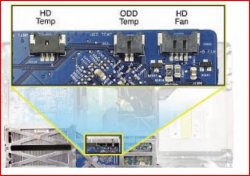So it seems a common thread with iMacs... the fans get all screwy.
I have tried a SMC reset, PRAM reset, removing the PRAM battery and shorting the power switch connector for a while all to no avail.
One observation that has me curious is that if there are no apps running the system goes to sleep and fan shuts off, however if I have an app open like FF and walk away, the screen will eventually turn off but the fan never does. In all other respects it seems to be in sleep mode but without the old slow pulsing light it is hard to be sure??
I was brave and powered up the system with the CPU fan disconnected The CPU was quite stable for a while and then rose reasonably quickly to around 50C while the CPU HS was at around 37C. That at least proves the sensors for the CPU are monitoring temp changes...
The wiring for the 4 wire fans have the following colours and there is a little ^ on the board near the connector. I assume this is pin 1 so that would make the following
Pin 1 Black - Control input - PWM input, wider pulse width = higher RMS voltage = higher fan speed
Pin 2 White - Tacho output - increased frequency = faster fan speed
Pin 3 Black - 0VDC (Ground)
Pin 4 Brown - +12VDC
So measuring the CPU tacho I get 126Hz = 7560RPM and iStat shows 3770RPM
The ODD tacho gives 33Hz = 1980RPM and iStat shows 980RPM
The ODD control input has 1.6V on it. I am trying to make the ODD temp rise to confirm that the control signal increases to drive the fan faster...
I have no explanation for why the actual fan speed Vs the measured speed is a ratio of about 2:1. I think that perhaps my cheap $20 meter is counting transitions (+ve and -Ve changes) rather than cycles.. Pity I don't have a CRO
With the ODD fan connected ad running at 980RMP (iStat) the control voltage is 1.6V
With the ODD fan disconnected, the control voltage is 12V
With the CPU fan connected ad running at 3850RMP (iStat) control the voltage is 12V
With the CPU fan disconnected, the control voltage is 12V
I have isolated the control wire on the fan assy and the fan shuts off as expected, this suggests that the internal FET is working OK.
The down side is that it also suggests I have a logic board fault.
With the fan off, I can monitor the tacho signal and manually spin the fan, iStat shows the fan speed but the control signal from the board remains at 12V, again suggesting that the logic board is faulty
I have confirmed that the control signal is not a hard short to the 12V supply and I have confirmed the CPU fan connector is OK by measuring all signals direct on the board.
I linked the control signal from the ODD fan to the control wire on the CPU fan and it ran at about 1000RPM proving the fan can be controlled.
I removed the logic board to look at it and attempt to trace the fan circuits... I was not able to find any obvious problems but as I don't have a circuit diagram I was unable to fully trace the circuits to check conclusively.
I did however make one discovery... I forgot to put the RAM in and when I booted so I got no video and a repeating beep. It took me a few minutes to realise my mistake but I did notice that in this state the CPU fan ran at normal speed/noise level.
That suggests the fan control circuit can indeed control the fan properly...
So now I am at square 1.... CPU fan runs high for no apparent reason and no apparent fault
Anyone know where I can get a full circuit diagram from??
I have tried a SMC reset, PRAM reset, removing the PRAM battery and shorting the power switch connector for a while all to no avail.
One observation that has me curious is that if there are no apps running the system goes to sleep and fan shuts off, however if I have an app open like FF and walk away, the screen will eventually turn off but the fan never does. In all other respects it seems to be in sleep mode but without the old slow pulsing light it is hard to be sure??
I was brave and powered up the system with the CPU fan disconnected The CPU was quite stable for a while and then rose reasonably quickly to around 50C while the CPU HS was at around 37C. That at least proves the sensors for the CPU are monitoring temp changes...
The wiring for the 4 wire fans have the following colours and there is a little ^ on the board near the connector. I assume this is pin 1 so that would make the following
Pin 1 Black - Control input - PWM input, wider pulse width = higher RMS voltage = higher fan speed
Pin 2 White - Tacho output - increased frequency = faster fan speed
Pin 3 Black - 0VDC (Ground)
Pin 4 Brown - +12VDC
So measuring the CPU tacho I get 126Hz = 7560RPM and iStat shows 3770RPM
The ODD tacho gives 33Hz = 1980RPM and iStat shows 980RPM
The ODD control input has 1.6V on it. I am trying to make the ODD temp rise to confirm that the control signal increases to drive the fan faster...
I have no explanation for why the actual fan speed Vs the measured speed is a ratio of about 2:1. I think that perhaps my cheap $20 meter is counting transitions (+ve and -Ve changes) rather than cycles.. Pity I don't have a CRO
With the ODD fan connected ad running at 980RMP (iStat) the control voltage is 1.6V
With the ODD fan disconnected, the control voltage is 12V
With the CPU fan connected ad running at 3850RMP (iStat) control the voltage is 12V
With the CPU fan disconnected, the control voltage is 12V
I have isolated the control wire on the fan assy and the fan shuts off as expected, this suggests that the internal FET is working OK.
The down side is that it also suggests I have a logic board fault.
With the fan off, I can monitor the tacho signal and manually spin the fan, iStat shows the fan speed but the control signal from the board remains at 12V, again suggesting that the logic board is faulty
I have confirmed that the control signal is not a hard short to the 12V supply and I have confirmed the CPU fan connector is OK by measuring all signals direct on the board.
I linked the control signal from the ODD fan to the control wire on the CPU fan and it ran at about 1000RPM proving the fan can be controlled.
I removed the logic board to look at it and attempt to trace the fan circuits... I was not able to find any obvious problems but as I don't have a circuit diagram I was unable to fully trace the circuits to check conclusively.
I did however make one discovery... I forgot to put the RAM in and when I booted so I got no video and a repeating beep. It took me a few minutes to realise my mistake but I did notice that in this state the CPU fan ran at normal speed/noise level.
That suggests the fan control circuit can indeed control the fan properly...
So now I am at square 1.... CPU fan runs high for no apparent reason and no apparent fault
Anyone know where I can get a full circuit diagram from??




